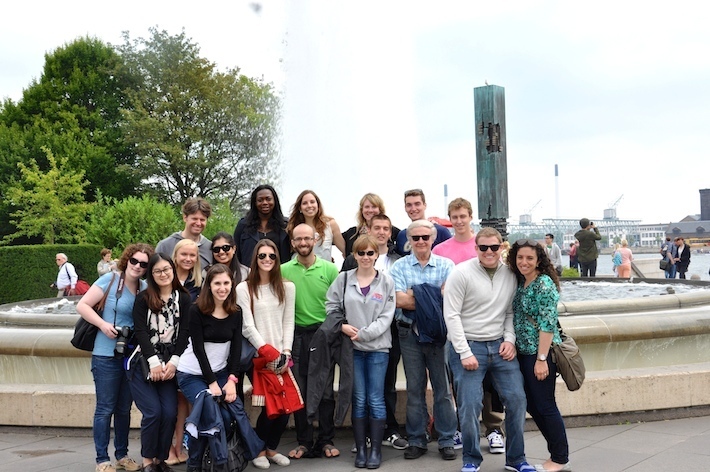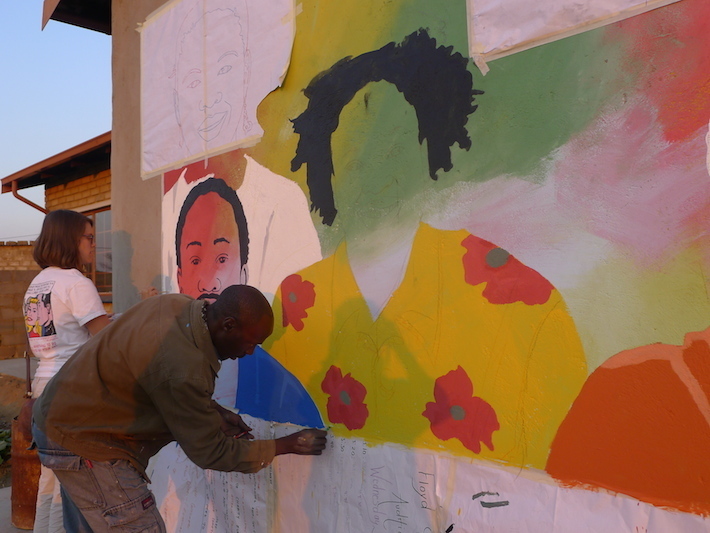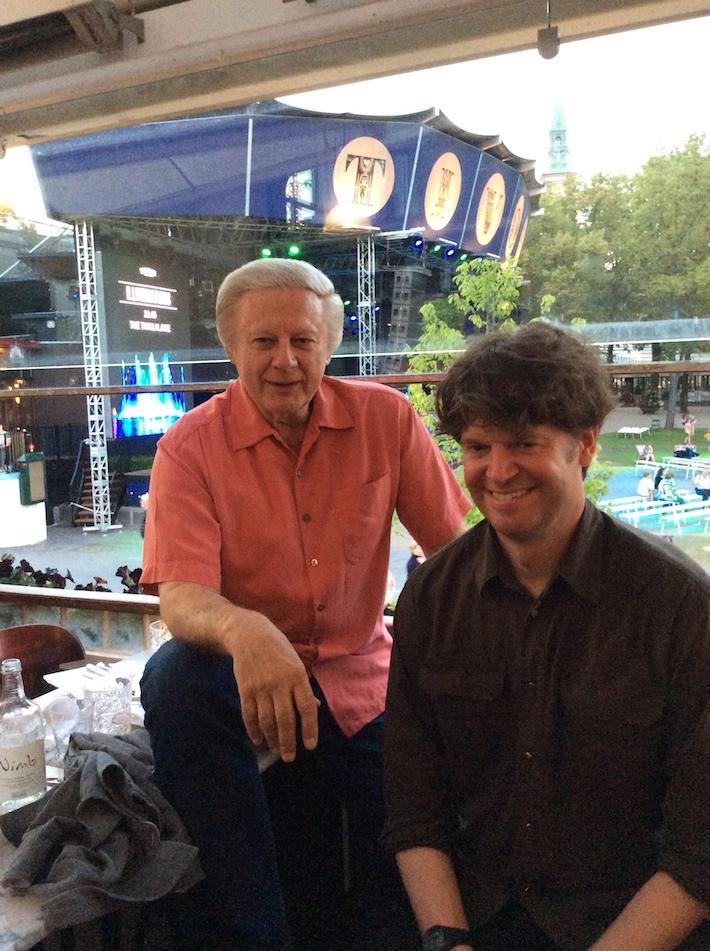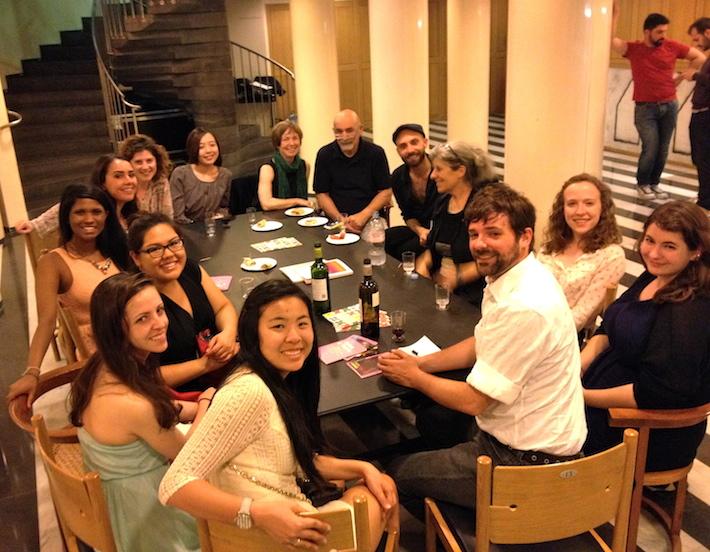Whether it’s learning about art in Europe’s epicenter of culture or analyzing international business with experts in Shanghai, the Columbian College often extends its lessons beyond the classroom—and past borders. This summer was no exception, and adventure enthusiasts packed their textbooks and embarked on scholarly expeditions to all corners of the world. George Washington Today rounded up some of the highlights students experienced while getting a taste of multiculturalism abroad.
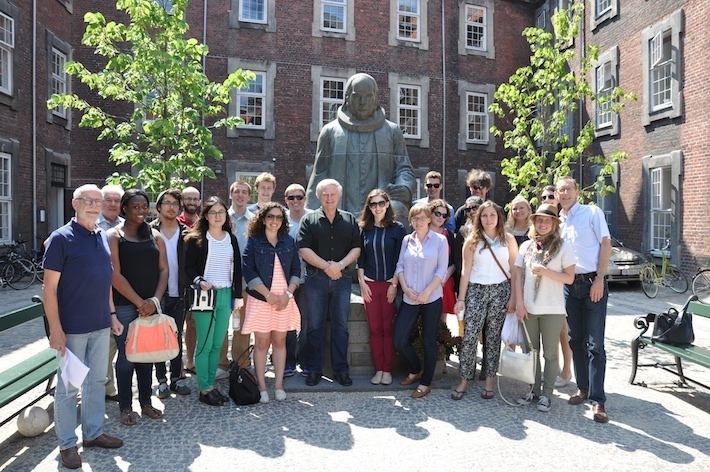
CCAS students in Denmark's Vartov courtyard.
Denmark has garnered international attention for its creativity: Copenhagen’s restaurant Noma is consistently named one of the world’s best for its whimsical interpretations of Nordic cuisine. Manufacturer Bang & Olufsen makes sound systems and audio products so cutting-edge that New York’s Museum of Modern Art shaped an entire exhibit around the company’s designs. To add to its inventive atmosphere, Denmark also ranks as the happiest country on the globe in an annual survey conducted by the University of Leicester.
The country is a paragon of innovation—and to professors Clay Warren and Nils Olsen, it seemed like the perfect place to study how organizational structures and societal values shape a person’s predisposition for creativity.
The two professors led 16 students through Copenhagen for 10 days during the field portion of their course “Communication, Decision-Making, and Innovation: The Special Case of Denmark.”
“This course was designed to facilitate a collective discussion of innovation and how the country’s model can be potentially replicated in other parts of the world,” Dr. Warren said.
The class met on campus for two intensive three-day sessions, building a conceptual base before getting to the country. Once they arrived in Copenhagen, the group visited businesses, educational institutions and cultural hubs to analyze organizational structures as well as communication and decision-making processes.
“Copenhagen is a natural selection given its high levels of creativity within the culinary, architectural and renewable-energy domains,” Dr. Olsen explained.
Junior Sonya Dhindsa, an organizational sciences major, had never been to Europe and wanted to understand how decision-making and business happens abroad. She found Denmark strikingly different than the U.S.—particularly, she felt, because some Danish government policies make it easier for people to develop at their own pace, leading to more creative freedom and innovation. These policies are grounded in the philosophy of Nikolai Grundtvig, the father of Danish adult education who advocated for the education of all people, regardless of gender and social status.
The class spent an afternoon at the historic and well-preserved Vartov, Grundtvig’s old headquarters, where Danish educators explained how their country’s approach to learning has paved the way for Danes to feel empowered to be creative.
Ms. Dhindsa also learned how company environments can motivate workers, something she paid special attention to during a visit to Greener Pastures, a Danish company that develops iPhone applications.
“Their office was really unique. It had a huge green wall and felt open and really beautiful. They said they prefer to have a more creative office because it inspires more thinking,” she said.
In addition to seeing Greener Pastures, students also visited the country’s National Museum; the 171-year-old TIVOLI Amusement Park; a number of ultra-modern buildings designed by the famed Bjarke Ingels Group (BIG); the Danish Royal Opera House and much more. The loaded schedule left Ms. Dhindsa with one piece of advice for students interested in taking the class next year: “Bring comfortable walking shoes. You’re going to do a lot of exploring."
Art therapy majors complete murals for the Bokamoso Youth Center.
Each time Professor Tally Tripp takes art therapy majors abroad, she notices a distinct change when they return.
“They come back to the U.S. much more culturally competent and self-aware because they are expected to look at their personal histories, perspectives and cultural biases as they provide culturally sensitive art therapy services in diverse international settings,” she said.
The university’s art therapy students have traveled to France, India and South Africa in past years. This summer, the department organized a second trip to South Africa so that 11 art therapy graduate students could apply their counseling skills in a multicultural environment.
Because of its history of race, gender and class issues, South Africa is a unique place to use arts and culture as a lens to understand social challenges. GW students worked primarily with Winterveld’s Bokamoso Youth Center, an organization for at-risk young people, and provided daily art therapy sessions.
Every morning, GW students woke up and gathered South African youths into a circle for morning songs, dances and drama exercises. They also participated in class discussions on cross-cultural topics and used their free time to get to know young South Africans more intimately by going on walks and visiting families.
“Spending mornings singing and dancing with the youth of Winterveld—in conjunction with leading art therapy groups in the afternoons—made my South Africa experience unforgettable. Every interaction was unique, and the acceptance of diversity was astounding,” said second-year graduate student Annie Gittess.
Theater professor Leslie Jacobson joined Ms. Tripp and helped design the course for art therapy students. She also served as a mentor to seniors Floyd Jones and Victoria Neiman-Vigo, two undergraduates conducting research projects in Winterveldt. Ms. Jacobson has developed an ongoing relationship between GW and the Bokamoso Youth Center—she has collaborated with composer Roy Barber to create 11 theater productions and three books of poetry that feature the work of young people from the center.
Ms. Jacobson explained that GW’s visit was particular helpful this summer because the Bokamoso community was dealing with the unexpected death of the center’s longtime director, Solomon Mahlangu.
“The arts played a vital part in their healing process,” she said. “Theater is a powerful transformative tool, enabling these young men and women of Bokamoso to express their thoughts and feelings, to develop focus and concentration, and to experiment with new behaviors through improvisation.”
She added that the undergraduate students were warmly welcomed into the Bokamoso community, and that both of them will help her plan the week-long GW visit by 12 Bokamoso youth, scheduled for February 2015.
One of the trip highlights occurred when Vusi Mtkawende, a talented South African artist, helped the group create two vibrant murals for the center. The mural project directly addressed the healing process for Bokamoso, and reflects the strengths and resiliency of the community. GW students grew closer to the Bokamoso youths as they worked side by side to mix paint by hand and brush images onto the building’s walls.
“In both mural processes, Bokamoso youth and GW students were really excited to share in the process and create large art pieces that will be positive reminders of the strength of the community and our work together,” Ms. Tripp said. “The experience was enriching for us all.”
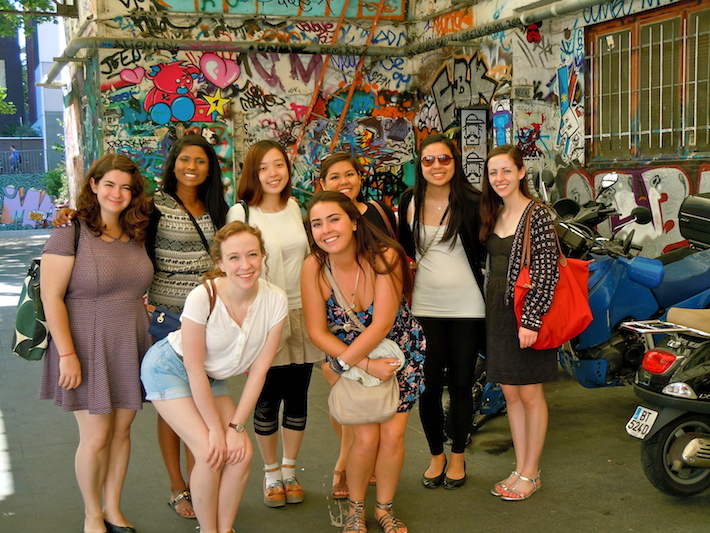
Students visit artist studios in Paris.
Paris in the early 20th century is remembered for its flourishing arts scene. At Gertrude Stein’s apartment on Rue de Fleurus, literary titans like Hemingway and Fitzgerald critiqued poems and prose. Nearby, the Ballet Russe thrived, leading to the production of the seminal “Rite of Spring.” In Giverny, Claude Monet paved the way for modernist painters with his love of nature and eye for color.
The era is one of Professor Mary Buckley’s favorites. To explore all the creative movements that took place at the time, she designed a course that allowed eight students to absorb some of the City of Art’s most breathtaking scenes: They hopped on bikes and wheeled their way through Monet’s picturesque gardens, spent three hours looking at towering Parisian buildings during an architecture tour, applauded performances produced by the Théâtre de la Ville and browsed 20th-century works at the Musée de l’Orangerie. The two-week experience gave students an unparalleled chance to take a closer look at the concepts they studied during an online portion of the class.
“It’s different when you see a picture of a painting on a computer screen versus learning about it and seeing it in all its glory—you understand the size and the scope,” said junior Katie Banks, a science major who used the trip as a chance to indulge her love for art.
The students also retraced the steps of the art world’s legends. The day they traveled to Monet’s home in Giverny, clouds rolled in and rain poured during most of their morning tour. But the weather cleared before the end of the visit, and the students were able to see Monet’s famed water lilies radiating under the sun.
“It didn’t make any sense—they were totally different colors. We realized that seeing them in the rain was a completely different experience than seeing them in the sun, and it helped us understand how Monet painted them,” Ms. Banks said.
As a Writing in the Disciplines course, the class required students to complete a research paper with the help of GW research librarian Bill Gillis. They also had to compile a daily journal, reflecting on the sights and smells they took in every day. That wasn’t a hard task for Ms. Banks, who had plenty of material to think about.
“Everything in Paris is a work of art, and it’s incredible to get to see that,” she said.
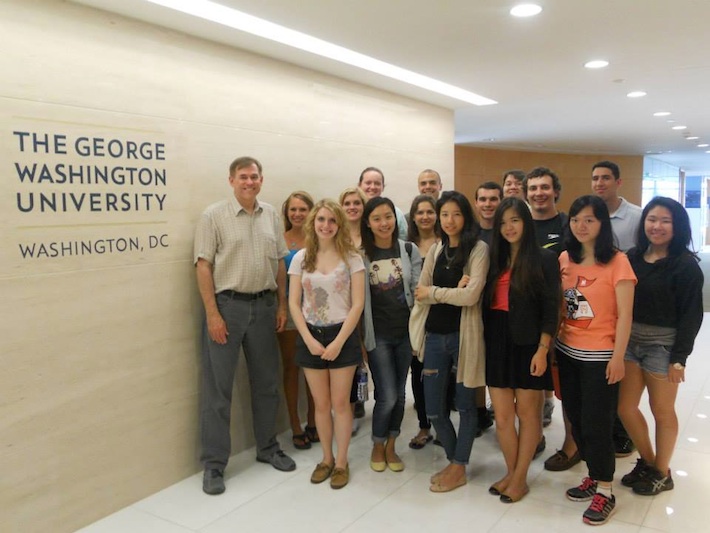
As part of the "Survey of International Economics" course held in Shanghai, students stop by GW's conference facility in Suzhou.
Reading about how today’s global market works is one thing. Understanding the intricacies of international economics while examining one of the world’s largest economies is a completely different ball game.
Professor Steve Suranovic led a rigorous “Survey of International Economics” course for the sixth year in a row this summer, complete with a two-week stay in Shanghai. Twelve undergraduate and three graduate students attended classroom sessions at Fudan University, a top college in China that has partnered with GW in the past.
“The short-term course in Shanghai is a fast-paced learning experience that offers immediate real-world exposure to the academic and conceptual issues covered in a standard class. As such, it is like international economics on steroids,” Dr. Suranovic said.
The class left no concept unexplored—the intensive syllabus covered international trade, finance and other topics related to U.S.-China’s relations in the global marketplace.
The itinerary in China was divided between lectures to supplement daily readings and site visits to explore connections with the economy. For example, students went on tours of Old and New Shanghai to get a sense of Chinese history and culture, and then attended lectures about current international policy issues affecting China and the U.S. GW alumnus Ted Hornbein, B.A. ’92, gave an overview of the U.S.-China business environment while a representative of the biotech startup firm Crystal Pharmatech discussed intellectual property issues in a presentation at the Suzhou Industrial Park.
While the academics of the class were demanding, students also had plenty of time to enjoy Shanghai city life. They enjoyed delicious, banquet-style meals featuring authentic Chinese dishes; strolled through the ancient Zhujiajiao water town; and had a tea reception with GW alumni living in the country.


